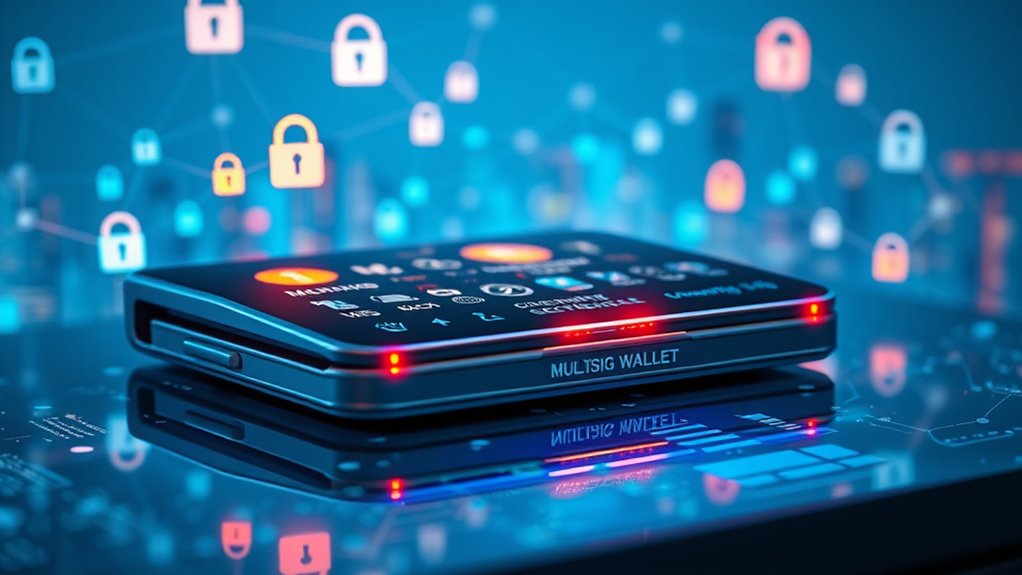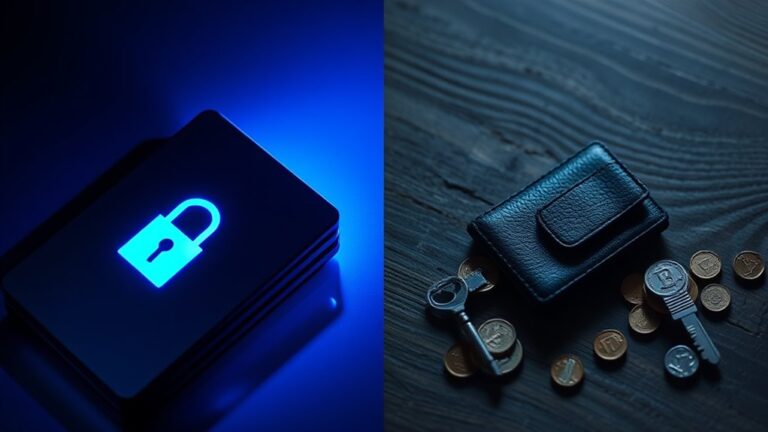
Multisig Wallets: How Do They Secure Your Crypto?
Multisig wallets secure cryptocurrency by requiring multiple signatures for transaction approval. This method distributes risk among several key holders, which reduces the chance of unauthorized access. Transactions begin with one signer but remain pending until all required signatures are collected. The wallet verifies these signatures before execution, promoting accountability through smart contracts. While multisig wallets enhance security, they also present challenges, such as complex key management. Further insights into their use and advantages can provide a broader understanding.
Key Takeaways
- Multisig wallets require multiple signatures for transactions, enhancing security by preventing unauthorized access and reducing single points of failure.
- They distribute key management among several parties, mitigating risks associated with losing a single private key.
- Strong passwords and two-factor authentication are often integrated, adding additional layers of security to the wallet.
- Smart contracts verify signatures before transaction execution, ensuring accountability and transparency in the process.
- Regular audits and communication among signers help maintain security and ensure all keys are effectively managed.
Understanding Multisig Wallets

Multisig wallets, which are designed to enhance security in cryptocurrency transactions, operate by requiring multiple signatures before a transaction can be authorized. The primary purpose of these wallets is to add layers of security through the use of multiple private keys.
Each wallet has a predetermined ratio of required signatures from the total keys involved, such as a 2-of-3 or 3-of-5 setup. These wallets are built on smart contracts that define the rules governing transactions.
Their adoption has grown among institutions and organizations for secure asset management. By distributing keys among multiple stakeholders, multisig wallets prevent single points of failure, ensuring that no single individual can control the funds without the consensus of others.
Security Advantages of Multisig

The security advantages of multisig wallets are notable, particularly regarding enhanced theft protection and the prevention of single-point failures.
By requiring multiple signatures for transactions, these wallets greatly reduce the risk of unauthorized access and transactions.
This distributed control not only strengthens asset security but also mitigates the potential impact of losing a single private key. Additionally, implementing strong, unique passwords and two-factor authentication can further bolster the security of multisig wallets.
Enhanced Theft Protection
Security in the digital age is a paramount concern, especially regarding cryptocurrency management. Multisig wallets enhance theft protection by requiring multiple signatures for transactions, which makes unauthorized access considerably more difficult. If one key is compromised, other keys remain secure, blocking unauthorized access.
This system promotes shared governance, as no single individual can control the funds entirely. Additionally, smart contracts are employed to define transaction rules, ensuring transparency and accountability.
Multisig wallets also incorporate error-checking mechanisms to reduce mistakes and allow for disaster recovery plans. By distributing approval rights and requiring consensus before critical transactions, these wallets effectively mitigate risks associated with theft, making them a robust option for securing digital assets. Furthermore, unlike custodial wallets that are more vulnerable to hacks, multisig wallets provide enhanced security control by requiring multiple approvals for access, reducing the likelihood of breaches.
Single-Point Failure Prevention
In the domain of cryptocurrency management, minimizing vulnerabilities is a key objective, particularly concerning single points of failure.
Multisig wallets effectively eliminate these risks by requiring multiple private keys to access funds. This design guarantees that no single key can control the assets independently, which greatly reduces the potential for loss.
The distribution of access among multiple stakeholders fosters collaboration and trust, as transactions necessitate the approval of several parties.
In addition, if one key is lost or compromised, funds remain accessible as long as the required number of keys is still intact.
This shared responsibility enhances security, making multisig wallets a reliable solution for managing digital assets against single-point failures. Furthermore, implementing two-factor authentication can further reinforce the security of multisig wallets by adding an extra layer of protection against unauthorized access.
The Transaction Process Explained

Multisig wallets utilize a structured transaction process that enhances security through the requirement of multiple signatures. This process begins when one signer initiates a transaction, signing it with their private key.
Multisig wallets enhance security by requiring multiple signatures for transactions, starting with one signer’s private key.
The transaction then remains pending until the necessary additional signatures are collected. Only after verifying these signatures does the wallet execute the transaction, broadcasting it to the blockchain.
Key aspects of this process include:
- Initiation by a signer: One signer starts the transaction with their private key.
- Signature collection: The transaction waits for the required number of signatures from other authorized parties.
- Verification and execution: The wallet checks the signatures before completing the transaction.
This multi-step approach considerably reduces the risk of unauthorized access and errors.
Use Cases for Multisig Wallets

The functionality of multisig wallets extends beyond enhancing transaction security; they also play a significant role in various practical applications.
In business, multisig wallets allow multiple executives to approve transactions, improving security and control over corporate funds. They also facilitate escrow services, where a third-party arbitrator can resolve disputes, ensuring fair transactions.
Families or groups can utilize multisig wallets for shared financial management, preventing any single person from having total control over the funds.
Additionally, in decentralized finance (DeFi), multisig wallets manage funds securely, integrating with smart contracts to enhance transparency. Moreover, these wallets leverage enhanced security measures through encryption and blockchain technology, further safeguarding assets against potential threats.
Challenges and Pitfalls of Multisig

Multisig wallets present several challenges that can complicate their use.
Key management is often intricate, as users must securely handle multiple keys and implement effective backup and recovery strategies to prevent loss.
Additionally, usability and accessibility issues may arise, especially for less experienced users, making it essential to simplify the setup and management processes.
Key Management Complexity
Managing keys in a multisig wallet presents several challenges that can complicate the overall user experience. The complexity arises from the need for multiple private keys, requiring careful coordination among participants.
- Complex Setup Process: Establishing a multisig wallet is more intricate than setting up a single-key wallet.
- Key Coordination: Multiple private keys necessitate communication between all users, which can delay transactions.
- Technical Expertise Requirement: Users often need a strong understanding of cryptographic principles to manage keys effectively.
These factors can deter individuals who may not possess the necessary technical skills, leading to potential errors in key management. Additionally, the security of cold wallets can provide a contrasting perspective on key management practices.
Consequently, while multisig wallets enhance security, they also introduce significant complexity that users must navigate.
Backup and Recovery Issues
When users opt for a multisig wallet, they encounter specific challenges related to backup and recovery that can complicate their experience.
The complexity of backups increases as multiple public keys from different hardware wallets must be secured. Extended public keys, or xpubs, are vital for recovery, but incomplete backups can jeopardize access to funds. A single missing key may result in complete lockout.
Recovery often requires coordinating with all parties involved, making the process cumbersome. Additionally, securely storing backups demands extreme caution, with physical media like metal plates recommended.
Encryption offers protection but introduces new risks if passwords are lost. Therefore, effective backup and recovery strategies are essential for the successful management of multisig wallets.
Usability and Accessibility Challenges
How can users effectively navigate the usability and accessibility challenges presented by multisig wallets? These wallets, while enhancing security, often introduce complexities that can be intimidating for less tech-savvy individuals.
- Technical Know-How Required: Users must understand intricate features, which can be overwhelming for beginners.
- Higher Setup Time: Coordinating among multiple parties leads to longer setup times compared to single-key wallets.
- Limited Cryptocurrency Support: Not all cryptocurrencies are compatible, complicating the use across different assets.
The combination of these factors can create significant barriers for users. As a result, seeking beginner-friendly options and responsive customer support is essential for a smoother multisig wallet experience. Additionally, users should be aware that multisig wallets require private and public keys to manage access to their digital assets effectively.
Understanding these challenges can help users make informed decisions about their digital asset management.
Future Developments in Multisig Technology

As the landscape of digital asset management evolves, multisig technology is poised for significant advancements that will enhance its functionality and security.
By 2025, over 75% of businesses dealing with digital assets are expected to adopt multisig wallets, driven by increasing security concerns. This technology is not limited to cryptocurrencies; it is expanding into business transactions, collaborative decision-making, and even inheritance planning.
By 2025, multisig wallets will become essential for over 75% of businesses managing digital assets, enhancing security across various applications.
Moreover, advancements in Multi-Party Computation (MPC) are improving key management and security. Smart contracts will provide flexibility in enforcing multisig requirements, while innovations aim to simplify wallet setups and reduce associated gas fees. Additionally, the rise of institutional adoption in the crypto market is likely to further drive the need for enhanced security measures like multisig wallets.
As these developments unfold, multisig wallets will likely become a standard in secure digital asset management for both individuals and institutions.
Comparing Multisig With Single-Key Wallets

In the domain of digital asset management, comparing multisig wallets with single-key wallets reveals significant differences in security, control, and usability.
Multisig wallets enhance security through multiple signatures, reducing the risk of asset loss if one key is compromised. In contrast, single-key wallets provide centralized control, making them simpler but less secure.
- Security: Multisig wallets distribute risk among several keys, while single-key wallets rely on one key.
- Transaction Speed: Single-key transactions are faster, as they require only one signature compared to the consensus needed in multisig setups.
- Cost: Multisig wallets often incur higher fees due to their complexity, whereas single-key wallets typically involve lower transaction costs.
Additionally, hardware wallets are a common choice for storing private keys securely, enhancing the overall security of any wallet setup. Understanding these differences helps users choose the right wallet type for their needs.
Best Practices for Managing Multisig Wallets

Managing multisig wallets effectively requires a thoughtful approach to security, configuration, and operational practices.
First, selecting reputable providers like Gnosis Safe or Electrum guarantees a secure foundation. It is important to choose wallets that support desired cryptocurrencies and offer user-friendly interfaces.
For key management, using hardware wallets from different vendors and storing keys in secure locations, such as fireproof safes, enhances security. The configuration should ideally employ a 2-of-3 setup for a balance of security and usability.
Regular audits, including checking signatures and updating firmware, are vital.
Finally, clear communication among signers is essential to navigate potential challenges, making sure that all stakeholders understand their roles and responsibilities.
These practices collectively fortify the management of multisig wallets.
Frequently Asked Questions
Can Multisig Wallets Be Used for Non-Cryptocurrency Assets?
Multisig wallets are primarily designed for cryptocurrencies, making their use for non-cryptocurrency assets limited. Although theoretically adaptable, practical applications in traditional finance remain sparse and require significant innovation for effective implementation.
How Do I Recover Lost Keys in a Multisig Setup?
Recovering lost keys in a multisig setup involves contacting wallet support, utilizing professional recovery services, organizing key management, experimenting with key order, and referring to specific recovery documents for guidance and solutions.
Are There Fees Associated With Multisig Wallet Transactions?
Multisig wallet transactions can feel like a costly labyrinth, often incurring hefty fees due to their intricate security features. Users must navigate varying costs across cryptocurrencies, making careful planning essential to mitigate these financial burdens.
Can Multisig Wallets Be Hacked?
Multisig wallets can be vulnerable to hacking, particularly through social engineering and human error. While they enhance security by requiring multiple signatures, attackers may exploit weaknesses in operational security rather than the technology itself.
What Happens if All Keys Are Lost in a Multisig Wallet?
In a grim scenario reminiscent of lost treasure, losing all keys to a multisig wallet results in irrevocable loss of funds. Without secure backups or recovery plans, users face the intimidating reality of inaccessible assets.
Conclusion
In conclusion, multisig wallets serve as a robust security measure for cryptocurrency management, akin to a bank vault requiring multiple keys to access. By distributing control among several parties, they enhance protection against theft and unauthorized access. While they offer numerous advantages, users must also navigate potential challenges and complexities. As technology evolves, the future of multisig wallets promises further advancements, making them an essential tool for secure digital asset management in an increasingly digital economy.












